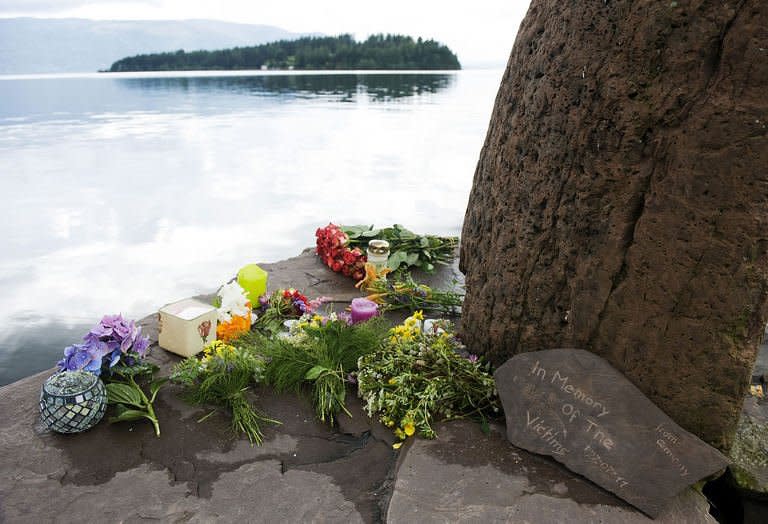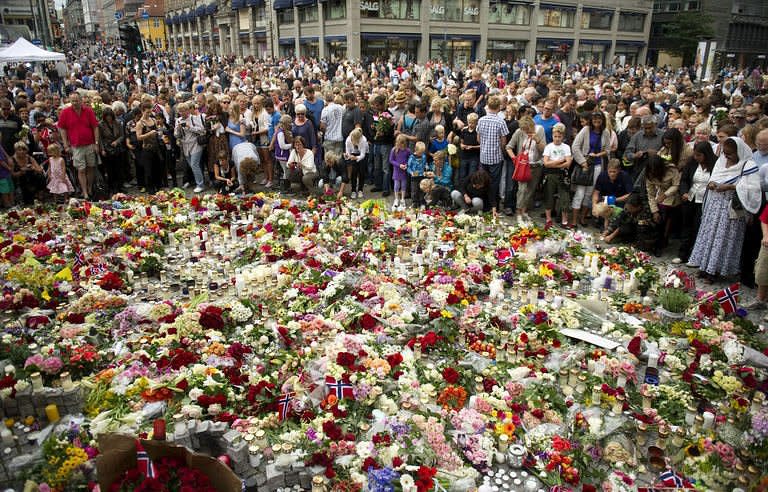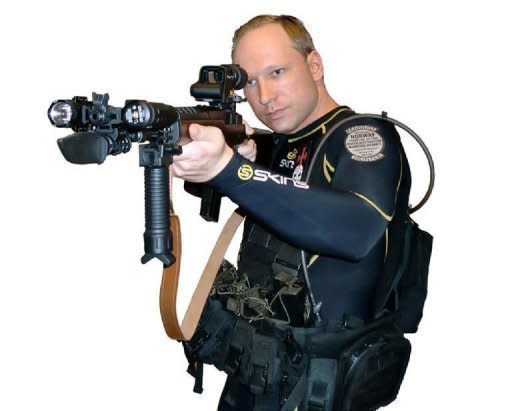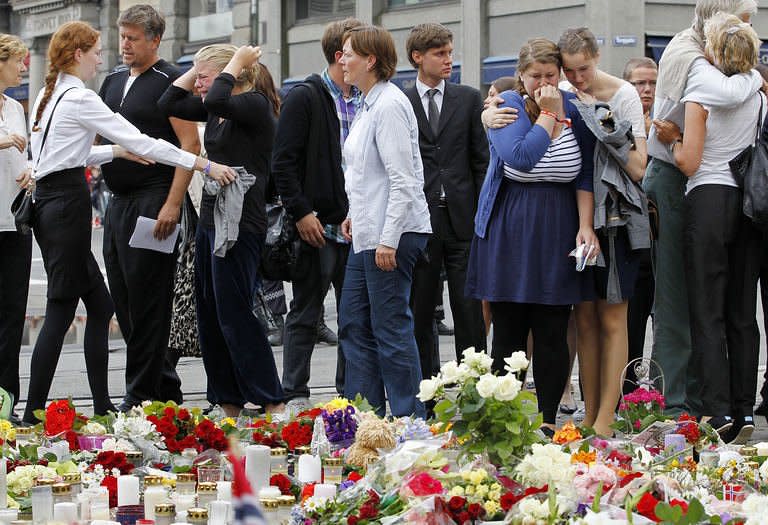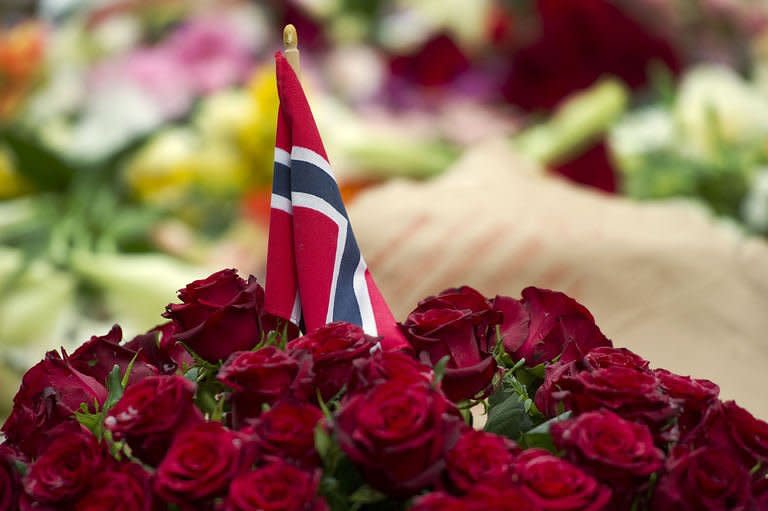Norway suspect faces court, police defend arrest delay
Self-confessed Norwegian mass killer Anders Behring Breivik faces justice Monday, after Oslo police defended the hour it took to reach the island where most of his 93 victims died in a hail of bullets. The author of a bombing and shooting spree that saw nearly 100 more wounded on Friday told interrogators he acted alone, police said Sunday, as the royal couple and a teary-eyed prime minister joined thousands attending a memorial service for the victims. Behring Breivik, 32, will run a central Oslo court-house gauntlet set for around 1:00 pm (1100 GMT) amid expected tight security. He has the status of 'official suspect' ahead of the arraignment, but will not learn actual charges until the investigation is concluded with police still hunting for possible accomplices. A minute's silence will be held across Norway at noon (1000 GMT). The murderous "crusade" unleashed by Behring Breivik, who acknowledged he would be called a "monster", was designed to end a centuries-long Muslim colonisation of Europe, he said in a 1,500-page tract released on the Internet. However, investigators said late Sunday that they had yet to uncover a motive for his actions. During weekend interrogation, Behring Breivik told police that his attacks were "cruel" but "necessary", yet while he "admitted responsibility", police said, his lawyer Geir Lippestad said he was not accepting "criminal responsibility", and that his client felt he had done "nothing reprehensible". At least seven people were killed in the initial car bomb blast outside government buildings in Oslo on Friday and a further 86 are dead after the shooting on the island of Utoeya, 40 kilometres away (25 miles) where a Labour party youth meeting was being held. The attacks have caused outrage in Norway amid calls for the reinstatement of the death penalty, given the maximum prison sentence the perpetrator can face is 21 years' imprisonment. If convicted, that would equate to less than 82 days per killing. Prime Minister Jens Stoltenberg and Norway's King Harald V and Queen Sonja led the nation in mourning at Oslo Cathedral. Stoltenberg said the "scale of the evil" would only fully emerge when the names and photographs of the mostly teenaged victims were published. The death toll rose to 93 on Sunday, after one of those wounded on Utoeya died in hospital. Names and photographs are to be released soon after the last of the dead were taken to city morgues for autopsy on Sunday. The list is expected to include offspring of senior ruling party figures. Police have not ruled out the involvement of a second gunman, and on Sunday they detained several people in a swoop on an Oslo property thought to be connected to the attacks. They were released shortly afterwards. "No explosives were found at the location," Oslo police said. A British police officer was in Norway on Sunday liaising with police there. Amid heavy criticism after police initially said it took an hour and a half to get to the scene of the second massacre, senior officer Johan Fredriksen told a news briefing the gap was closer to an hour. Fredriksen said that there was an eight-minute gap between the time local police on Utoeya first notified Oslo authorities, at 5:30 pm (1530 GMT), and formally requested help at 5:38 pm. Armed Oslo police arrived on the island by boat at 6:25 pm, with Behring Breivik surrendering two minutes later. Acting police commissioner Sveinung Sponheim said that all the dead had now been removed from the island and "taken to the coroner's morgue where the autopsies will be carried out". At the emotion-filled service, Stoltenberg wiped his face with a handkerchief and told the hushed congregation that despite the tragedy Norway would demonstrate "more democracy, more openness, more humanity, but without naivety." He and the leader of the Labour Party's youth group, Eskil Pedersen, each laid a white rose near a sea of flowers in an improvised shrine beforehand. Investigators were Sunday poring over the manifesto in which the suspect said he had been preparing the "martyrdom operation" since at least late 2009. Part diary, part bomb-making manual and part Islamophobic rant, the "compendium" details how he set up front mining and farming businesses to prepare the attacks. As harrowing testimony emerged from the summer camp where scores of youngsters were mown down, Norway was struggling to understand how a country famed as a beacon of peace could experience such bloodshed on its soil. The toll could rise further with an unspecified number of people still unaccounted for both from the island and government buildings. The attacks on Friday afternoon were western Europe's deadliest since the 2004 Madrid bombings, carried out by the Al-Qaeda terror network. Anti-fascist monitors have said Behring Breivik was a member of a Swedish neo-Nazi Internet forum named Nordisk. On arrival at the island, he wore a police pullover and claimed to be investigating the bomb attack and began opening fire with an automatic weapon. The shooting spree lasted for around 90 minutes before he surrendered to armed police arriving on the island. Witnesses described scenes of horror among the more than 500 people attending the youth camp. Some who tried to swim to safety were even shot in the water. Police said 97 people had been injured in the attacks, 30 by the car bomb in central Oslo and 67 in the shooting rampage on Utoeya.

